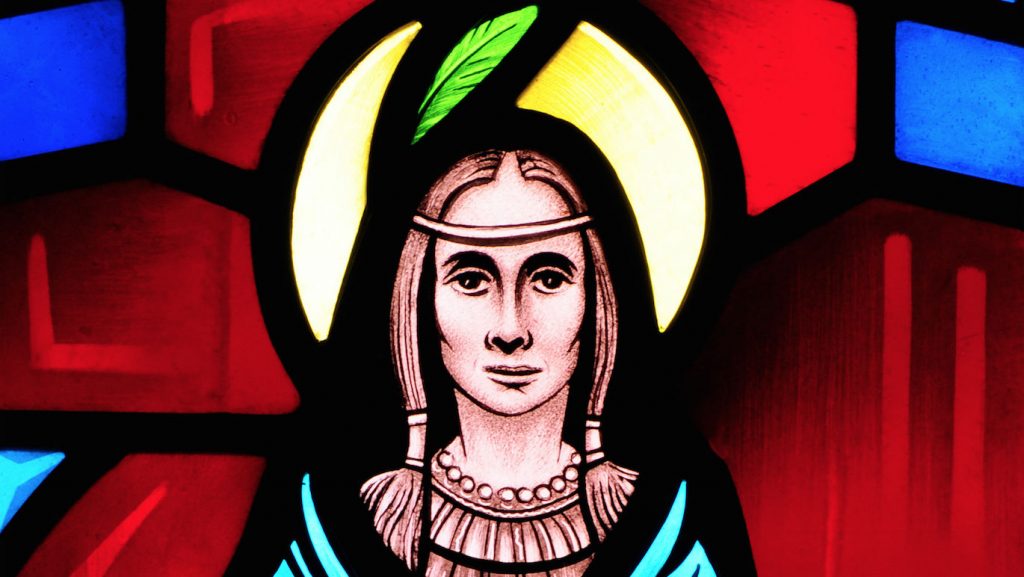Three hundred years have passed since St. Kateri Tekakwitha walked the earth, but her life resonates with Catholics even today. In her 24 short years, she experienced great suffering: the early loss of parents, severe disfigurement, disability, war, life as a refugee, slander, persecution and misunderstanding from those closest to her. But she also lived a life of great joy and great love in Jesus Christ, nourished by a Native American Catholic community that wanted to become saints too.
St. Kateri Tekakwitha was born in 1656 at Ossernenon (near present-day Auriesville, N.Y.), a major town of the Mohawk nation also known as the Kanien'keha (People of the Flint), one of the Five Nations of the Haudenosaunee (also known as the Iroquois Confederacy).
St. Kateri’s father was Kenneronkwa, a chief of the Turtle Clan, which 10 years before St. Kateri’s birth, had tried to protect St. Isaac Jogues from the martyr’s death he eventually received at the hands of members of the Bear Clan who resented his presence in Ossernenon. Her father married an Algonquin Catholic woman, adopted into the Turtle Clan, named Tagaskouita.
St. Kateri would be no stranger to suffering and loss. At 4 years old, her parents died of smallpox. The disease disfigured her face and damaged her eyes so badly she was given the name “Tekakwitha” or “she who bumps into things.”
At 10 years old, she had to flee for her life when a French military expedition in 1666 burned down the Mohawk villages and food supplies, causing great hunger. She lived as a refugee until her people could rebuild their towns and plant their crops again.
When Jesuit missionaries came to live at her new village of Caughnawaga, she was impressed by the example of “the black robes,” and decided to learn the Catholic faith from them. At 19 years old, she was baptized, taking the name “Kateri” for the mystic St. Catherine of Siena.
However, St. Kateri’s profession of the faith of “the true men who make the sign of the cross” (as the Haudenosaunee Catholics came to be known), created friction with her other family and community. When she refused to marry — the Haudenosaunee greatly esteemed marriage, motherhood, and family in their culture — her relatives became deeply angry with her and her faith.
The Jesuits helped St. Kateri join an intentional community of Haudenosaunee Catholics at a place called Kentake (or Laprairie) on the St. Lawrence River. They went to Mass every day, prayed morning and evening prayer together, went to confession and received Holy Communion frequently, and prayed the rosary, integrating their faith with their culture. St. Kateri practiced many harsh penances that would not be recommended today, however, they always proceeded from a desire to draw close to Jesus whom she loved.
Eventually, St. Kateri became the second consecrated virgin in this community’s history, and explained her decision in nuptial terms: “I have consecrated myself entirely to Jesus, son of Mary, I have chosen Him for husband and He alone will take me for wife.”
She died in 1680 during Holy Week. Her last words were “Jesus, Mary, I love you.”
Upon death, her face appeared beautiful again. In the few weeks after death, St. Kateri appeared to her clan mother and mentor, Anastasia Tegonhatsiongo, her best friend Marie-Therèse Tegaiaguenta, and Jesuit Father Claude Chauchetière, to comfort them and tell them she was going to Heaven.
St. Kateri Tekakwitha, the “Lily of the Mohawks,” became the first recognized Native American saint with her canonization by Benedict XVI. Pilgrims can visit her beautiful tomb, and ask for her prayers, in the peaceful church of St. Francis Xavier mission in the Mohawk territory of Kahnawake, Canada.

